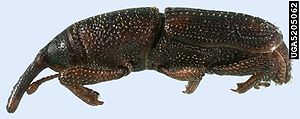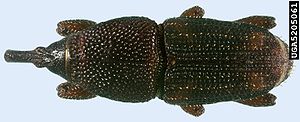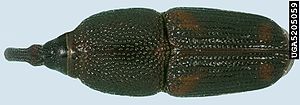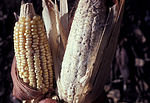- Maize weevil
-
Maize weevil 
Scientific classification Kingdom: Animalia Phylum: Arthropoda Class: Insecta Order: Coleoptera Family: Curculionidae Genus: Sitophilus Species: S. zeamais Binomial name Sitophilus zeamais
(Motschulsky)The maize weevil (Sitophilus zeamais), known in the United States as the greater rice weevil,[1][2] is a species of beetle in the family Curculionidae. It can be found in numerous tropical areas around the world, and in the United States, and is a major pest of maize.[3] This species attacks both standing crops and stored cereal products, including wheat, rice, sorghum,[4][5][6] oats, barley, rye, buckwheat,[6] peas, and cottonseed. The maize weevil also infests other types of stored, processed cereal products such as pasta, cassava,[5] and various coarse, milled grains. It has even been known to attack fruit while in storage, such as apples.[7]
Contents
Description
A close relative of the rice weevil,[6] the maize weevil has a length of 2.5 mm to 4 mm.[1][2] This small, brown weevil has four reddish-brown spots on the wing covers (elytra). It has a long, thin snout, and elbowed antennae.[6] Sitophilus zeamais appears similar to the rice weevil (Sitophilus oryzae), but has more clearly marked spots on the wing covers, and is somewhat larger.[2] It is able to fly.[6]
Although the maize weevil and rice weevil do look alike, and are easily confused with one another, there are several distinguishing features:[7]
Maize weevil (S. zeamais) Rice weevil (S. oryzae) Circular punctures on pronotal dorsum Longitudinally elliptical punctures on pronotal dorsum Pronotal punctures have no median puncture-free area and are nearly equally spaced apart Pronotal punctures are separated by a flat, median, longitudinal puncture-free zone More than 20 pronotal punctures along the approximate midline, running from neck to scutellum Less than 20 pronotal punctures along the approximate midline, running from neck to scutellum Scutellar elevations relatively farther apart compared to their longitudinal length Scutellar elevations relatively closer together compare to their longitudinal length Scutellar elevations extend longitudinally approximately halfway down the scutellum Scutellar elevations extend longitudinally approximately more than halfway down the scutellum Proepimera meets behind the fore coxae and has a barely discernable notch along the posterior edge at the site of the meeting point
Proepimera meets behind the fore coxae and along the posterior edge, has a distinct curved notch Aedeagus has two dorsal, longitudinal grooves Aedeagus (in males) is smooth and shiny on the dorsal surface Distribution
S. zeamais occurs throughout warm, humid regions around the world, especially in locations where maize is grown,[2] including: Polynesia, Argentina, Brazil, Burma, Cambodia, Greece, Japan, Morocco, Spain, Syria, Turkey, United States, USSR, and Yugoslavia. It is also widely distributed throughout agricultural areas of northern Australia.[7] This species has also been recorded Canada, in the provinces of Ontario and Quebec,[6] and has been intercepted at ports, but is not well established there. It has, however, been present for several years in Montreal, where grain from the U.S. is stored.[8]
Life cycle
The complete development time for the life cycle of this species averages 36 days.[7] The female chews through the surface of the grain, creating a hole. She then deposits a small oval white egg, and covers the hole as the ovipositor is removed, with a waxy secretion that creates a plug.[6] The plug quickly hardens, and leaves a small raised area on the seed surface. This provides the only visible evidence that the kernel is infested.[7] Only one egg is laid on inside each grain. When the egg hatches into a white, legless grub, it will remain inside and begin feeding on the grain. The larvae will pupate while inside, then chew a circular exit hole,[1] and emerge as an adult beetle. A single female may lay 300 to 400 eggs during her lifetime. Adults can live for 5 to 8 to eight months.[2] Breeding conditions require temperatures between 15 and 34° C and 40% relative humidity.
When the adults emerge, the females move to a high surface and release sex pheromones. Males are then attracted to this pheromone.[7]
Host range
The maize weevil commonly attacks standing crops, in particular, maize before harvest, and is also commonly associated with rice. It infests raw or processed cereals such as wheat, oats, barley, sorghum, rye and buckwheat. It can breed in crops with a moisture content of a much wider range than S. oryzae, and has been found in fruit, such as apples during storage. Although the maize weevil cannot readily breed in finely processed grains, it can easily breed in products such as macaroni and noodles, and milled cereals that have been exposed to excessive moisture.[7]
Damage and detection
Early detection of infestation is difficult. As S. zeamais larvae feed on the interior of individual grains, often leaving only the hulls, a flour-like grain dust, mixed with frass is evident. Infested grains contain holes through which adults have emerged. A possible indication of infestation is grain, when placed in water, floating to the surface.[7] Ragged holes in individual grains, similar to damage caused by the rice weevil and granary weevil, may indicate infestation.[6] In large stores of grain, an increase in temperature may be detected. The most obvious sign of infestation is the emergence of adults. One study recorded, 5 weeks after infestation, the emergence of 100 adults per kg per day.[1]
Control
Instead of calling Pest Control for weevil problems in your kitchen, put the 'problem' food (such has pasta, flour, cereal) into the freezer for 24 hours. This will kill the weevils and hopefully eliminate any further weevil problems in your kitchen. The weevils originally come into the household in packaged food and gradually spread into other foods that are not stored properly. Pasta, flour, cereal (etc) needs to be packaged in an air-tight container to prevent weevil contamination.
See also
- Granary weevil, also known as the wheat weevil (S. granarius)
- Rice weevil (S. oryzae)
- Home stored product entomology
- Invasive species
- List of common household pests
- Pest control
References
- ^ a b c d "PestWeb | Greater Rice Weevil". Agspsrv34.agric.wa.gov.au. http://agspsrv34.agric.wa.gov.au/ento/pestweb/Query1_1.idc?ID=-1055010548. Retrieved 2010-07-29.
- ^ a b c d e "Greater Rice Weevil (Sitophilus zeamais)". Ozanimals.com. http://www.ozanimals.com/Insect/Greater-Rice-Weevil/Sitophilus/zeamais.html. Retrieved 2010-07-29.
- ^ "Greater Rice Weevil (Sitophilus zeamais)". Ozanimals.com. http://www.ozanimals.com/Insect/Greater-Rice-Weevil/Sitophilus/zeamais.html. Retrieved 2010-08-01.
- ^ http://agspsrv34.agric.wa.gov.au/ento/pestweb/Query1_1.idc?ID=-1055010548>
- ^ a b Control of Sitophilus zeamais Mots., 1958 and Sitophilus oryzae (L., 1763) weevils (Coleoptera, Curculionidae) in stored rice grain (Oryza sativa l.) with insecticide pirimiphos methyl (Actellic 500 CE) B. Alleoni1, W. Ferreira 9th International Working Conference on Stored Product Protection
- ^ a b c d e f g h "Maize weevil". Grainscanada.gc.ca. 2009-12-21. http://www.grainscanada.gc.ca/storage-entrepose/pip-irp/mw-cr-eng.htm. Retrieved 2010-07-29.
- ^ a b c d e f g h http://www.padil.gov.au/pbt/index.php?q=node/70&pbtID=217
- ^ "Beetles Identification Guide" (PDF). http://home.cc.umanitoba.ca/~fieldspg/fields/beetles.pdf. Retrieved 2010-07-29.
Further reading
- Proctor, D.L. 1971. An additional aedeagal character for distinguishing Sitophilus zeamais Motsch. from Sitophilus oryzae (L.) (Coleoptera: Cuculionidae). Journal of Stored Products Research, 6: 351-352.
- Peng, W.K., Lin, H.C., Wang, C.H. 2003. DNA identification of two laboratory colonies of the weevils, Sitophilus oryzae (L.) and S. zeamais Motschulsky (Coleoptera: Curculionidae) in Taiwan. Journal of Stored Products Research, 39(2): 225-235.
- Meikle, W.G., Holst, N., Markham, R.H. 1999. Population simulation model of Sitophilus zeamais (Coleoptera: Curculionidae) in grains stores in West Africa. Environmental Entomology, 28(5): 836-844.
- Nardon, C, Nardon, P. 2002. New characters to distinguish larvae and adults of the two sibling species: Sitophilus oryzae(L.) and S. zeamais Mots. (Coleoptera, Dryophthoridae). Annales de la Societe
- Meagher, R.L., Reed, C., Mills, R.B. 1982. Development of Sitophilus zeamais and Tribolium castaneum in whole, cracked, and ground pearl millet. Journal of the Kansas Entomological Society, 55(1): 91-94.
- Maceljski, M., Korunic, Z. 1973. Contribution to the morphology and ecology of Sitophilus zeamais Motsch. in Yugolsavia. Journal of Stored Products Research, 9: 225-234.
- Mason, L.J. (2003). Grain Insect Fact Sheet, E-237-W: Rice, Granary, and Maize Weevils Sitophilu soryzae (L.), S. granarius (L.), and S. zeamais (Motsch). Purdue University
- Danho, M., Gaspar, C., Haubruge, E. 2002. The impact of grain quantity on the biology of Sitophilus zeamais Motschulsky (Coleoptera: Curculionidae): oviposition, distribution of eggs, adult emergence, body weight and sex ratio. Journal of Stored Products Research, 38(3): 259-266.
- Anonymous. 2009b. Maize weevil Sitophilus zeamais (Motsch.) Canadian Grain Commission.
External links
Categories:- Curculionidae
- Agricultural pest insects
- Invasive animal species
Wikimedia Foundation. 2010.





